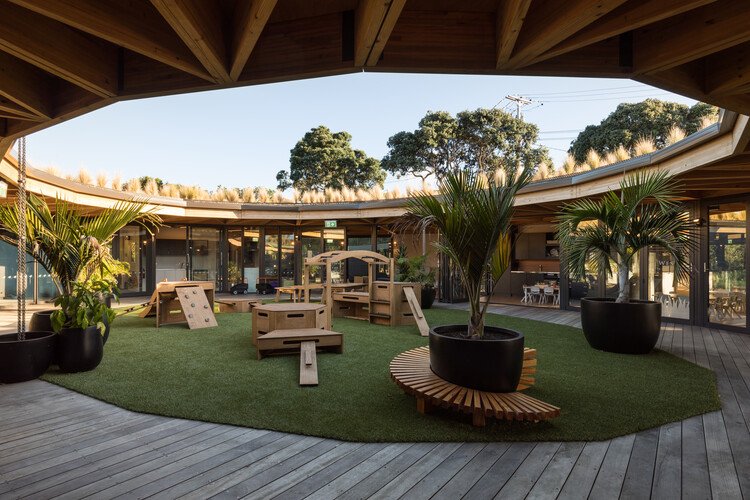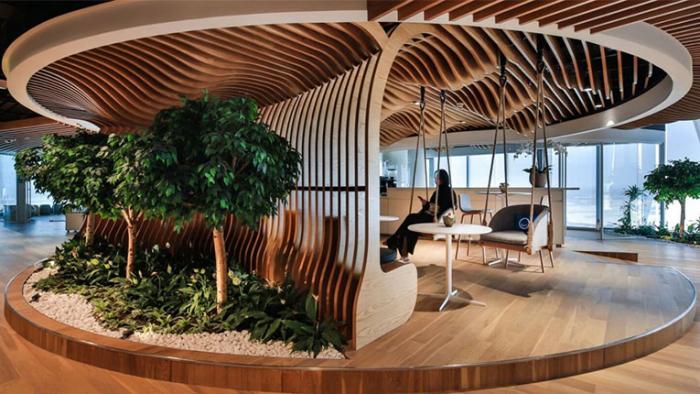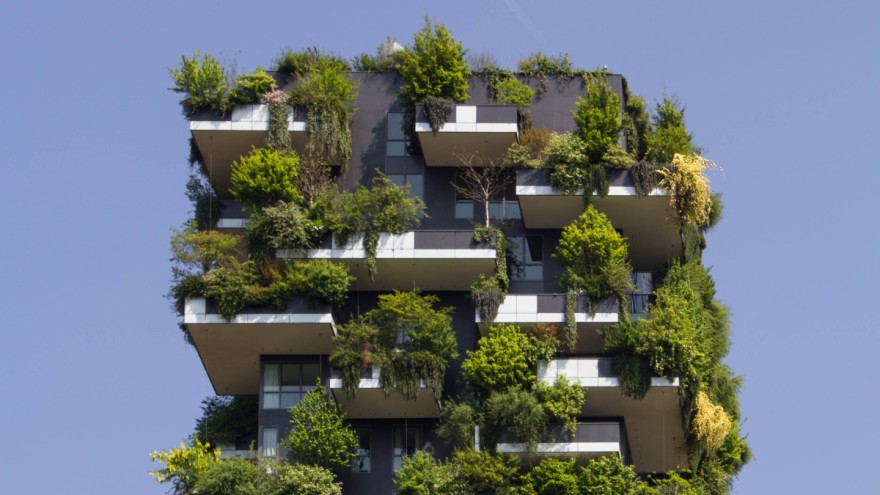Biophilic Design in Schools and Educational Facilities.
Biophilic design represents an approach that underscores the connection between nature and the built environment, particularly within educational settings, which emphasizes environmental psychology and the integration of natural patterns.
As educational institutions adapt to the requirements of modern learners, the integration of natural elements into design, such as sustainable architecture and green spaces, has become increasingly essential.
This article examines the importance of biophilic design in schools, emphasizing its positive effects on student wellbeing, cognitive development, and educational outcomes.
Key design elements, practical applications, and exemplary case studies are analyzed to demonstrate how nature-inspired environments can enhance educational experiences through the inclusion of indoor plants and acoustic comfort.
What Is Biophilic Design?
.jpg_00.jpeg)
Biophilic design represents a progressive methodology in architecture and interior design that aims to establish a connection between individuals and nature through the incorporation of natural elements, patterns, and materials within the built environment.
This concept underscores the significance of crafting spaces that promote human well-being by adhering to sustainable architectural principles that advocate for ecological design and nurture an emotional bond with the natural world.
In educational settings, biophilic design has the potential to revolutionize classrooms and learning environments, thereby improving student performance and engagement while simultaneously minimizing ecological footprints.
Why Is Biophilic Design Important in Schools and Educational Facilities?
Biophilic design is essential in schools and educational facilities as it creates environments that promote student well-being, enhance learning outcomes, and foster a connection to nature.
In an increasingly urbanized world, the incorporation of biophilic design principles can lead to improved air quality, increased exposure to natural light, and overall health benefits for students, fostering a visual and physical connection to nature.
By cultivating restorative environments that encourage outdoor learning and community engagement, biophilic design significantly enhances the educational experience and contributes to the emotional resilience of students through nature-based learning.
What Are the Benefits of Biophilic Design in Schools?
The advantages of biophilic design in educational institutions extend beyond mere aesthetic considerations; they encompass a variety of psychological and physical benefits that contribute to a more effective learning environment. By incorporating elements such as indoor plants, natural light, and views of nature, schools can significantly enhance student engagement, increase productivity, and promote overall health and safety.
Research has demonstrated that exposure to natural environments can lead to improved cognitive development, enhanced emotional well-being, and a stronger sense of community among students, ultimately fostering a supportive and inclusive educational experience.
A study published in the Journal of Environmental Psychology found that students exposed to natural elements performed up to 15% better on tests compared to their counterparts in traditional classrooms. This increase in academic performance can be attributed to reduced stress levels and improved concentration, both of which are essential for effective learning.
Furthermore, biophilic design has been shown to elevate students’ mood and motivation; a survey revealed that classrooms with ample natural light experienced a 20% increase in student attendance.
By prioritizing these natural elements, educators not only enhance learning outcomes but also cultivate an environment that fosters collaboration, creative learning, and creativity among students.
How Does Biophilic Design Improve Learning and Academic Performance?
Biophilic design plays a crucial role in enhancing learning and academic performance by creating environments that stimulate cognitive development and promote active learning experiences. The integration of natural elements, such as daylighting, flexible classroom layouts, and outdoor learning spaces, not only improves student focus but also fosters collaboration and creativity.
By establishing a connection between students and nature, educational facilities can cultivate a sense of curiosity, mindfulness, and engagement that leads to higher academic achievement and improved information retention.
For example, incorporating large windows to maximize natural light can mitigate fatigue and elevate mood, thereby positively influencing students’ concentration levels. Additionally, the introduction of indoor plants or green walls within classrooms not only enhances the aesthetic appeal of the environment but also improves air quality and psychological benefits, leading to a more relaxed and engaged student body.
Moreover, outdoor classrooms, where lessons are conducted in natural settings, further enhance the learning experience by providing real-world contexts and encouraging physical activity, both of which are known to boost cognitive function and support nature immersion.
These design features effectively reduce stress levels and foster a nurturing environment that supports not only academic success but also holistic wellbeing and resilience.
What Are the Key Elements of Biophilic Design?
The key elements of biophilic design serve as foundational components that facilitate the creation of nurturing and restorative environments, particularly within educational facilities, by promoting ecological sustainability and sensory-rich environments.
These components encompass the optimization of natural light, the integration of indoor plants, and the incorporation of nature-inspired patterns and materials to enhance both the aesthetic and sensory experiences of the space, promoting visual connection and ecological impact.
By prioritizing these elements, biophilic design aims to cultivate a significant connection between students and their environment, thereby enriching their learning experience.
1. Natural Light and Views
Natural light and views of nature are fundamental components of biophilic design, as they play a significant role in influencing student wellbeing and academic performance by offering sensory experiences and visual aesthetics. By optimizing daylighting through the strategic placement of windows and skylights, educational institutions can create bright and inviting spaces that minimize reliance on artificial lighting while enhancing thermal comfort and energy efficiency.
Access to natural views promotes an emotional connection to the environment, which can contribute to improved focus, productivity, and social interaction among students.
Research indicates that exposure to natural light can elevate mood and cognitive function, underscoring its importance in educational settings, where design strategies focus on adaptability and user experience. For example, a study conducted by the University of Illinois revealed that classrooms with abundant daylight resulted in higher test scores and increased student engagement.
To achieve these benefits, schools can adopt effective design solutions, such as site-specific design, that consider adaptability and urban greenery.
- Incorporating large glass walls that provide views of gardens
- Strategically planting trees to frame outdoor vistas
Additionally, integrating outdoor classrooms allows students to engage in learning within a natural setting, further strengthening their connection to the landscape while providing enriching educational experiences.
2. Natural Materials and Textures
.jpg_01.jpeg)
The incorporation of natural materials and textures in biophilic design cultivates a tactile and visually engaging environment that resonates with students across multiple sensory dimensions. Utilizing materials such as wood, stone, and plant-based textiles promotes an ecological design ethos that enhances the aesthetic appeal of educational facilities while simultaneously fostering sustainability, cultural relevance, and environmental stewardship.
These materials evoke a sense of warmth and comfort, thereby enriching the overall learning experience and supporting emotional wellbeing.
For example, employing sustainably sourced wood for furniture and flooring not only ensures durability but also establishes a connection to nature that can enhance focus and creativity. Stone elements, whether utilized in walls or as decorative accents, impart a sense of permanence and stability, while the use of plant-based textiles for upholstery or curtains can introduce a vibrant yet calming ambiance.
By thoughtfully integrating these materials, educators can create classrooms that are not only visually appealing but also reinforce a teaching philosophy centered around respect for the environment, thereby fostering a generation that values sustainability and ecological literacy.
3. Indoor Plants and Greenery
Incorporating indoor plants and greenery into educational spaces is a vital component of biophilic design that yields numerous health benefits, including improved air quality, enhanced student focus, and increased biodiversity. Plants contribute to a healthier indoor environment by filtering pollutants and increasing oxygen levels. Additionally, they provide a sensory experience that connects students to nature, fostering emotional wellbeing and reducing stress, thereby enhancing emotional safety. Research indicates that exposure to greenery can enhance cognitive function and promote a positive classroom atmosphere.
The presence of indoor plants can stimulate creativity and decrease absenteeism by creating a more inviting and engaging learning environment. Educators can introduce a variety of suitable species, such as:
- snake plants
- pothos
- spider plants
These plants thrive in low-light conditions and require minimal maintenance.
By strategically placing these plants throughout classrooms or in common areas, schools not only enhance the aesthetic appeal of the environment but also establish a natural stress-relief tool for students, engaging them in experiential learning. Furthermore, the incorporation of greenery into classroom design can serve as an engaging project that encourages collaboration and a sense of responsibility among students as they participate in the care and maintenance of their green companions, integrating community collaboration.
4. Water Features
Water features represent a compelling aspect of biophilic design that can significantly enhance sensory experiences and foster a calming atmosphere within educational facilities. The soothing sounds of water have been shown to reduce stress and anxiety levels among students, thereby creating a restorative environment that is conducive to learning.
By incorporating elements such as fountains, ponds, or water walls, educational institutions can facilitate immersion in nature and deepen students’ emotional connections to their surroundings.
These installations not only serve as aesthetically pleasing focal points but also provide valuable interactive learning opportunities. For example, a pond can be utilized as a practical resource for science lessons focused on ecosystems or local wildlife, promoting hands-on exploration and inquiry.
Water walls, characterized by their visually appealing designs, can function as noise barriers while simultaneously creating a serene space for reflection and study.
The presence of water has been associated with enhanced creativity, enabling students to think more freely and engage with their work on a deeper level. Ultimately, integrating these features nurtures both emotional well-being and academic growth, transforming the learning environment into a sanctuary that supports holistic development.
5. Biophilic Patterns and Shapes
Biophilic patterns and shapes are essential in establishing visual connections to nature within educational environments. By incorporating natural shapes and patterns—such as fractals, spirals, and organic forms—designers can evoke a sense of harmony and familiarity that enhances the overall aesthetic appeal.
These design principles not only enrich the visual experience but also stimulate cognitive engagement and foster creativity among students.
When integrated thoughtfully, biophilic patterns can have a significant impact on learning outcomes. For instance, incorporating natural light and utilizing leaf-like shapes in architectural design can improve focus and reduce stress, thereby creating an inviting atmosphere that is conducive to learning.
Classroom furniture designed with curved lines that mimic natural forms encourages movement and interaction among students. Such environments promote a deeper connection not only to their surroundings but also to the learning process itself, enhancing overall well-being and productivity.
This engagement through natural aesthetics can ultimately lead to improved information retention and a more holistic educational experience.
How Can Biophilic Design Be Incorporated in Schools and Educational Facilities?
Incorporating biophilic design into schools and educational facilities necessitates a comprehensive approach that integrates natural elements and fosters a connection to the environment throughout the educational experience.
Implementation strategies may include:
- the establishment of outdoor classrooms,
- the installation of indoor green walls,
- and the incorporation of nature-based learning activities that encourage exploration and interaction with natural surroundings.
By embedding biophilic principles into the educational framework, institutions can enhance student engagement and promote overall well-being.
1. Outdoor Classrooms and Learning Spaces
Outdoor classrooms and learning spaces exemplify a significant application of biophilic design, promoting nature exploration and enhancing environmental education. These spaces, designed with natural elements such as gardens, seating areas, and shade trees, offer an immersive learning environment that engages students’ senses and cultivates a deeper connection to the natural world.
By leveraging outdoor settings, educators can create dynamic learning experiences that support holistic learning and overall well-being.
Research has shown that outdoor experiences can notably enhance students’ focus, creativity, and problem-solving abilities. These classrooms facilitate hands-on learning, allowing students to participate in activities such as planting, scientific observation, and art projects inspired by their natural surroundings.
Successful initiatives, such as the Edible Schoolyard project in Berkeley, California, illustrate that incorporating gardens into the curriculum not only enhances students’ comprehension of nutrition and ecology but also fosters teamwork and a sense of responsibility.
In conclusion, outdoor classrooms have the potential to transform the educational landscape by instilling a sense of stewardship for the environment, making learning more relatable and impactful.
2. Indoor Green Walls and Vertical Gardens
.jpg_10.jpeg)
Indoor green walls and vertical gardens represent innovative elements of biophilic design, effectively bringing the benefits of nature into interior spaces. These living walls, comprised of a variety of plants, not only improve air quality but also offer a sensory experience that supports nature therapy and enhances emotional well-being among students.
By incorporating green walls into classrooms and communal areas, educational institutions can cultivate a connection to nature while simultaneously enhancing the overall aesthetic appeal of their environments.
Research indicates that the presence of greenery can significantly reduce stress levels and foster a sense of tranquility, making indoor green walls a valuable asset in any educational setting.
When planning such designs, it is essential to carefully consider factors such as wall height, plant selection, and lighting to optimize both aesthetic value and plant health. Selecting a diverse array of species, including air-purifying plants like spider plants and snake plants, can further augment the functionality of these installations.
Additionally, the strategic placement of these walls can create microclimates that support plant growth, ensuring a thriving ecosystem that benefits both students and the surrounding environment.
3. Natural Play Areas
Natural play areas represent a crucial component of biophilic design, fostering creativity, social interaction, and sensory experiences among students. These environments, constructed with natural materials and incorporating elements such as logs, boulders, and plants, encourage children to engage with their surroundings and explore their creative potential.
By offering a variety of play opportunities, natural play areas support physical, emotional, and social development in alignment with holistic learning principles.
Such environments not only promote physical activity but also play a significant role in the development of critical social skills, including teamwork and communication.
For example, a primary school in the Pacific Northwest successfully transformed its conventional playground into a forest-themed natural play area. This redesign included climbing structures made from fallen trees and pathways adorned with wildflowers, resulting in a marked increase in student engagement during recess as children collaborated on imaginative games inspired by their natural surroundings.
Another exemplary case is a community park in Australia that features a series of interconnected natural zones. These zones allow children to explore diverse textures and terrains, thereby enriching their sensory experiences and stimulating their creativity.
These successful implementations illustrate the transformative impact of natural play areas, give the power toing children to learn through active play while nurturing essential life skills.
4. Biophilic Art and Decorations
Biophilic art and decorations play a vital role in enhancing the educational environment by fostering emotional connections and visual associations with nature. The incorporation of nature-inspired art, murals, and decorations into educational spaces can create inviting and stimulating environments that inspire creativity and engagement among students.
By reflecting the beauty of the natural world, these elements contribute to an overall atmosphere that promotes well-being and facilitates learning.
When students are surrounded by biophilic art, they frequently experience reduced stress and increased focus, both of which are essential for academic success. For example, schools that have implemented living walls or nature-themed murals have reported significant improvements in student mood and concentration.
An exemplary initiative is the ‘Nature Gallery’ project, wherein students collaborated to create large-scale paintings that depict local flora and fauna. Such projects not only allow students to express their creativity but also cultivate a sense of community and connection to their environment, ultimately enhancing their emotional well-being and academic performance.
What Are Some Examples of Biophilic Design in Schools and Educational Facilities?
Examples of biophilic design in schools and educational facilities exemplify innovative methodologies for integrating natural elements into learning environments, leading to improved learning outcomes and enhanced student well-being.
Features such as indoor gardens and outdoor classrooms demonstrate the effective application of biophilic design principles in creating functional and adaptable spaces that promote collaboration and community engagement.
By adopting biophilic design, educational institutions have the opportunity to transform their environments and facilitate holistic learning experiences.
1. The Green School in Bali
The Green School in Bali exemplifies biophilic design, effectively integrating sustainable architecture with outdoor learning environments that foster a connection between students and nature.
This innovative institution features classrooms constructed from natural materials, enveloped by lush gardens and open spaces that promote exploration and experiential learning. By emphasizing ecological sustainability and holistic education, The Green School serves as an inspiring model for schools and educational facilities globally, showcasing the importance of sustainable architecture and nature integration in learning environments.
Key attributes of this educational institution include large, retractable doors that seamlessly connect indoor and outdoor spaces, facilitating the influx of fresh air and natural light into the learning environment. This design promotes student wellbeing and environmental psychology by creating nature-inspired spaces with excellent air quality and acoustic comfort.
The use of curved bamboo structures and abundant natural light is intentionally designed to create a calming atmosphere that encourages creativity, cognitive development, and concentration. This approach enhances the sensory experiences of students, fostering emotional wellbeing and mindfulness.
These design elements not only enhance student engagement but also promote a significant sense of well-being. Students are encouraged to take breaks in nature, engage in hands-on projects, and cultivate a sustainable mindset through practices like nature therapy and restorative environments.
The integration of the environment into daily learning activities fosters a strong relationship between students and the natural world, ultimately enriching their educational experience and shaping them into responsible future citizens. This approach emphasizes the importance of ecological literacy and nature-based learning.
2. The Bullitt Center in Seattle
The Bullitt Center in Seattle serves as a prime example of biophilic architecture, demonstrating a strong commitment to sustainability and community engagement while functioning as a living laboratory for environmental education and ecological impact through design strategies that enhance educational outcomes.
This innovative building integrates numerous biophilic design elements, including abundant natural light, green roofs, rainwater harvesting systems, and urban greenery, which collectively create a restorative environment conducive to both human health and ecological balance, ensuring energy efficiency and health benefits.
As an educational facility, the Bullitt Center inspires visitors and students to adopt principles of sustainability and environmental stewardship through educational equity and experiential learning.
By incorporating features such as large windows that seamlessly connect indoor spaces to the natural environment, the center encourages occupants to appreciate the surrounding flora and fauna. Furthermore, interactive displays and educational workshops emphasize the fundamental principles of resource conservation, eco-friendly practices, and connectivity between built and natural environments.
This multifaceted approach not only educates but also empowers individuals to take proactive measures within their communities toward sustainable living, promoting social interaction and collaborative learning.
As a model for future educational and community spaces, the Bullitt Center exemplifies how thoughtful design can enhance understanding of environmental issues and inspire collective action for the betterment of the planet.
3. The New York Hall of Science
.jpg_11.jpeg)
The New York Hall of Science utilizes biophilic design principles to establish an interactive learning environment that seamlessly incorporates elements of nature into its exhibits and educational programs. By featuring green roofs, outdoor learning spaces, and the use of natural materials throughout the facility, the Hall fosters a deeper understanding of science and sustainability, encouraging educational outcomes and environmental stewardship.
This innovative approach encourages visitors to engage with the natural world while nurturing curiosity, creative learning, and creativity among students through immersive learning and place-based education.
The design strategically incorporates elements such as abundant natural lighting, living walls, water features, and indoor plants, thereby enhancing sensory experiences and making the learning process not only informative but also immersive, promoting psychological benefits and tranquility.
Visitors are afforded the opportunity to explore scientific principles through hands-on exhibits that replicate natural processes, thereby establishing a tangible connection between educational content and real-world applications. This environment serves not only to educate but also to inspire individuals to think critically about environmental challenges, enhancing their awareness and sense of responsibility towards nature, and fostering emotional safety and resilience.
Through this careful integration of design elements, the Hall effectively cultivates a generation that values sustainability, innovation in the field of science, and environmental education, ensuring historic context and cultural relevance.
4. The Children’s Nature Institute in Los Angeles
The Children’s Nature Institute in Los Angeles exemplifies biophilic design, focusing on nature-based learning and environmental education for children. This facility integrates outdoor classrooms, natural play areas, and immersive environments that encourage exploration, discovery in nature, and site-specific design, promoting learning environments and community spaces.
By prioritizing community engagement and ecological literacy, the Children’s Nature Institute fosters a nurturing environment that promotes holistic learning, ecological sustainability, and an appreciation for the natural world through educational facilities and collaborative learning.
The design principles of the institute emphasize the seamless integration of built environments with natural landscapes, allowing young learners to engage directly with ecosystems. Features such as water elements, native plant gardens, and wildlife habitats function as living laboratories, nurturing curiosity, respect for biodiversity, and enhancing sensory-rich environments.
This immersive approach not only enhances individual learning experiences but also cultivates a sense of responsibility toward environmental stewardship among children through curriculum integration and interdisciplinary learning.
The institute actively encourages families and community members to participate in programs and workshops, thereby strengthening local connections and fostering a collective commitment to sustainability. Through these initiatives, the institute plays a crucial role in shaping future generations who are informed advocates for environmental conservation, promoting wellness-focused design and nature immersion.
Frequently Asked Questions
What is biophilic design in schools and educational facilities?
Biophilic design is an approach to designing learning environments that incorporates elements of nature into indoor and outdoor spaces to improve student well-being and academic performance.
How does biophilic design benefit students in schools and educational facilities?
Biophilic design has been shown to improve student focus, reduce stress, and enhance creativity and critical thinking skills. It also promotes a sense of connection to the natural world, which can have positive effects on mental health and overall well-being.
What are some key elements of biophilic design in schools and educational facilities?
Some key elements of biophilic design include natural lighting, views of nature, use of natural materials such as wood and stone, incorporation of plants and greenery, and creating spaces for outdoor learning and activities.
How can biophilic design be implemented in existing schools and educational facilities?
Biophilic design can be incorporated into existing schools and educational facilities through simple changes such as adding plants and natural light, or by redesigning spaces to include more natural elements. Collaboration with architects and designers can help create a biophilic environment that suits the needs of the school.
Are there any challenges to implementing biophilic design in schools and educational facilities?
Some challenges to implementing biophilic design may include budget constraints, limited outdoor space, and restrictions on building design. However, there are many cost-effective and creative ways to incorporate biophilic elements into learning environments.
Is there research to support the effectiveness of biophilic design in schools and educational facilities?
Yes, there is a growing body of research that shows the positive effects of biophilic design on student performance, well-being, and overall learning experience. This research can serve as evidence for educators and administrators looking to implement biophilic design in their schools and educational facilities.

I’m Bruno, an architect with a deep passion for Biophilic Design in Urban Architecture. Throughout my career, I’ve focused on integrating natural elements into urban planning, and I created this site to share my insights and foster a deeper understanding of how biophilic principles can significantly enhance urban living. Dedicated to sustainable development, I continually explore innovative design solutions that promote both environmental and human well-being in city landscapes.














Publicar comentário